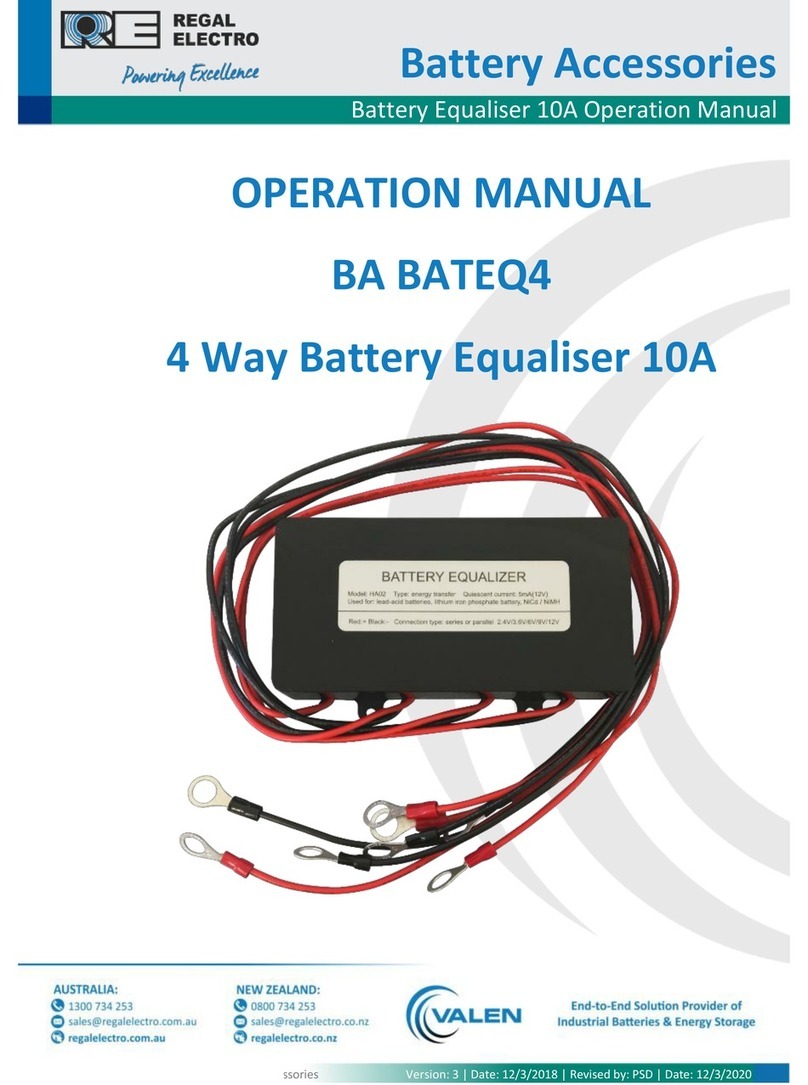heat and to prevent temperature differences from arising
in the string. If the batteries are installed in a cabinet, it
should be designed to allow unobstructed air circulation
and prevent temperature build-up. Use angle iron
support rails instead of shelves. If the batteries are on
racks, sufficient air circulation should be present to
prevent temperature-layering effects. In an improperly
designed room, there can easily be a 5°C difference in
temperature between the floor and the ceiling. If this
difference exists in a series string, it will result in a need
for equalisation and in reduced battery life.
5.1.3.2 Ventilation and Gassing
As noted, lead acid batteries emit small amounts of gas
during normal charging and floating. The gas
composition while on float is approx. 80% by volume
hydrogen with the remainder being oxygen.
CAUTION! Hydrogen has can be explosive. Never install
batteries in an airtight enclosure. Ventilation must be
provided to remove this hydrogen gas. Allow about
1L/hour/battery of air exchange to prevent hydrogen
accumulation.
5.1.4 Floor Loading
Before installing the batteries, it should be ascertained
that the floor has the capability to support the weight of
the battery, rack or cabinet and related equipment. The
total system weight will be the sum of the batteries, rack
or cabinet plus 5% for the battery connectors. It is the
responsibility of the installer to ensure adequate floor
load carry in capabilities.
5.2 Seismic Considerations
VALEN X-CEL Batteries are capable of withstanding
seismic events of UBC Zone 4 magnitude when properly
installed in a suitably designed cabinet or rack. When
seismic capability is desired, suitable floor anchoring
should be provided. Proper floor anchoring is the
responsibility of the installer.
5.3 Installation - Cabinets
When installing VALEN X-CEL Batteries in cabinets, follow
the recommendations of section 5.1.3.1 regarding
cabinet ventilation. Ensure that the batteries are
electrically insulated from the cabinet frame. Standard
battery spacing is 12mm minimum between battery
blocks. If the cabinets are to be seismic rated, the
batteries must be firmly attached to the cabinet to
prevent battery shifting during a seismic event. Proper
installation is the responsibility of the installer.
5.4 Installation - Racks
5.4.1 Existing Racks
When VALEN X-CEL Batteries are to be installed on
existing racks, ensure the racks are:
1. Of proper size for the intended battery
2. Have sufficient weight carrying capability for the
intended battery, including seismic considerations, and of
sufficient size to hold the number of blocks (plus the
12mm needed between blocks) for the complete system.
Before the new batteries are installed, touch up any
nicks, scratches or acid marks on the rack with the paint
provided by the manufacturer. Ensure that the rail
insulators are in good condition or replace. Check that
the rack is level and re-level if necessary. Check the floor
anchors and re-torque all bolts of the rack to
manufacturer’s specifications.
5.4.2 New Racks
Assemble the rack according to the manufacturer’s
instructions. Ensure that the rack is level and all bolts are
properly torqued.
5.4.3 Installation
Determine the location of the positive and negative
terminals of the battery with respect to the rack location.
When placing batteries on the rack, alternate the
polarities for proper intercell connection. Standard
spacing between blocks is 10mm. Position the batteries
on the rack. Do not drop.
5.5 Electrical Connections
Proper battery electrical connections are very important
for the best battery performance and utility. Improper
battery connections can cause a loss of standby time or
even a battery fire. Follow the electrical connection
instructions carefully and review section 2.4 thoroughly
before working on the battery.
CAUTION! Remove all rings and watches before
installing the connectors on the batteries. Ensure that
all tools are insulated with vinyl electrical tape to
prevent shorting. Do not reach or lean across batteries
on step racks. Remember, hazardous voltages are
present. Be aware of what you are touching at all times.
5.5.1 Cabling Recommendations
Battery ratings are specified at the terminals of the
battery. The cabling used to connect the battery
terminals to the load has a voltage drop (when the
battery is discharging) that is dependent on cable length
and conductor size. The longer the cable run, the greater
the voltage-drop. The smaller the cable wire diameter,
the greater the voltage drop. Therefore, to get the best
performance from the battery short, heavy cables are
recommended. Do not size the cables based on current





























